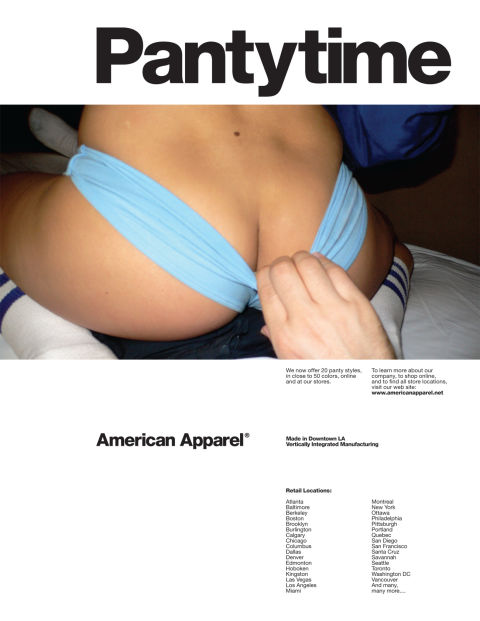COMING TO A CLEARANCE BIN NEAR YOU SOON.. AMERICAN APPAREL

When I think American Apparel, I think camel toes in spandex – and as I learnt from being very up close in the crowd underneath Madonna’s crotch on stage one Summer – possibly wearing their senior citizens leotard range that hugged “a part” of her so tightly, I thought someone in the audience would run up to perform the Heimlich on it – nothing good comes of wearing the stretch material.
No fashion retailer has single-handedly managed to make spandex so unappealing unless you’re under 10 years-old or you’re professional tiny wigged dancer Maddie Ziegler – because when Maddie rolls around in that high on the good shit interpretive dance style she does, it brings out the competitive talent show kid who wants to wear a leotard in all of us.
Unfortunately, the reality is the average-sized person who squeezes into anything stretchy by AA, (even if the t-shirts were only made in one size to fit all, regardless of gender), many average-sized people also looked like they had squeezed a farm animal under their top.
Not content with assaulting our eyes from bulging stretch cotton, then there is the notorious back-catalogue of controversial advertising which helped boost AA’s notoriety from famous to infamous: with their sex-sells to promote the objectifying male gaze, NSFW-laden images, branded “soft porn” and “exploitive of young women”, because you know what… call me old-fashioned, but I always assumed if you were trying to sell clothes, then sell some damn clothes. Not the bare rear end of some 20-year-old in just a pair of socks.
But let’s count the positives to AA, such as their sweatshop-free production; and as the biggest clothing manufacturer in North America, their garment workers received higher wages and “comprehensive healthcare and benefits”. AA also championed immigration reform and campaigned for LGBT issues, having creating the now iconic “Legalize Gay” t-shirts.
However, after numerous attempts at restructuring the company and a highly-publicised bankruptcy filing, American Apparel has finally been sold to Gildan – a Canadian company who basically make most of the tees, hoodies and sweatshirts which logos or graphics are printed on. The sale means that all of the 110 US American Apparel stores will close, (12 of its UK stores closed in December last year), and its factory will close too.
AA’s demise is indicative of a greater cultural trend though, as those higher wages for workers and management costs of the “Made in USA” label, although ethical, came at a very expensive price. Fast-fashion is now the customer’s favourite, because why pay more for goods made fairly, when most people it seems would prefer to buy from retailers who are offshoring their manufacturing practices to countries like Bangladesh, India, Cambodia and Vietnam because of their low wages, lax local labor laws and agreements of free trade – or to put it another way, consumers love to buy clothing that costs the same as 5 bags of Cheese Doritos, made by underpaid workers forced to work 84 hours a week without breaks earning probably $1 an hour.
Goodbye AA, even those gold metallic leggings which made the perfect costume when the party invite said “come dressed as the inside of a chocolate wrapper”, just couldn’t save it.

